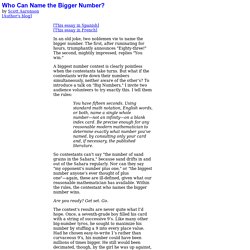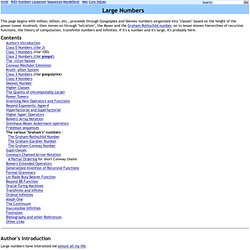

Who Can Name the Bigger Number? [This essay in Spanish][This essay in French] In an old joke, two noblemen vie to name the bigger number.

The first, after ruminating for hours, triumphantly announces "Eighty-three! " The second, mightily impressed, replies "You win. " A biggest number contest is clearly pointless when the contestants take turns. But what if the contestants write down their numbers simultaneously, neither aware of the other’s? So contestants can’t say "the number of sand grains in the Sahara," because sand drifts in and out of the Sahara regularly. Are you ready? The contest’s results are never quite what I’d hope. And yet the girl’s number could have been much bigger still, had she stacked the mighty exponential more than once. . , for example. Or Place value, exponentials, stacked exponentials: each can express boundlessly big numbers, and in this sense they’re all equivalent. How big is a Googol, anyway? A friend of mine told his son that a Googol is a huge number.

My kids caught on, so now I hear googol used in conversation all the time. You know, like this: I could eat 100 chocolate Easter eggs! I could eat 1000! Oh Yeah? A googol is 10 100 . After hearing googol-bombs dropped all the time like this, you sort of get inured to it. Huh. So, the question I want to ask is: is there anything that has a googol of it in the universe? Let’s start with some standard “big quantity” things.
The number of grains of sand on the earth. I don’t really care about accuracy here. There are seven quintillion five quadrillion grains of sand on all the beaches of the world. So, in scientific notation that’s 7.5 x 10 18 . How many stars are there? Okay, let’s up the ante a bit. With this simple calculation you get something like 10 22 to 10 24 stars in the Universe. Obviously, these numbers are nowhere near big enough. How many atoms are in the universe? We’re getting closer! So, that gives us ~ 10 89 . Cool! Article: The Biggest Numbers in the Universe, by Bryan Clair. 2 April 2001 W hat's the biggest number you've ever seen?

Think about it fondly for a moment, because it's going to be blown away. Yes, you can always add one. Yes, you can multiply by ten, or a million. Yet the number you're thinking of is a speck on the knee of the world's smallest flea compared to what's coming. Pebbles Before we get to the really big numbers, let's start with a look at what passed for big a few thousand years ago. As civilization developed, marks were arranged into groups, usually of five or ten. . , which evolved into M. And for 10,000 and 100,000. Thirty-two times. 3.2 million is a remarkably large number for a system using grouping. Powers of Ten The Indians, however, developed a spectacular tower of numbers. In ancient India, enormous numbers took on special religious significance, and among all civilizations (even to this day) they were unique in having names for many higher powers of ten.
"Consider a trough whose diameter is of the size of the earth. "Space is big. These are the biggest numbers in the universe. Large Numbers at MROB. This page begins with million, billion, etc., proceeds through Googolplex and Skewes' numbers (organized into "classes" based on the height of the power-tower involved), then moves on through "tetration", the Moser and the Graham-Rothschild number, on to lesser-known hierarchies of recursive functions, the theory of computation, transfinite numbers and infinities.

If it's a number and it's large, it's probably here. Contents Author's Introduction Class 0 Numbers (like 3) Class 1 Numbers (like 100) Class 2 Numbers (like googol) The -illion Names Conway-Wechsler Extension Knuth -yllion System Class 3 Numbers (like googolplex) Class 4 Numbers Skewes' Number Higher Classes The Quality of Uncomputably Larger Power Towers Inventing New Operators and Functions Beyond Exponents: hyper4 Hyperfactorial and Superfactorial Higher hyper Operators Bowers' Array Notation Steinhaus-Moser-Ackermann operators Friedman sequences.